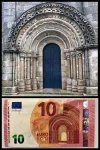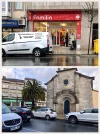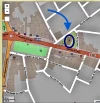- Time of past OR future Camino
- Francés and routes in Andalucia
The other day when we were in Melide, we took a close look at Iglesia San Pedro because the author of the Moon Camino de Santiago guidebook says its Romanesque church doorway served as a model for the illustration on the 10 euro note. (Edited to add: be sure to read @kathar1na’s note below clarifying this with a link to an article by two Galicians from Melide saying this is not the case!) When you are walking through Melide, you may be more likely to be paying attention to the pulperías on your left with their steaming vats prominently displayed, but just after you pass by Pulpería Garnacha and Pulpería Ezeqquiel, look across the street and you will see Iglesia de San Pedro (on the right side of the N-547 as you are heading west). On some maps, it is called Capilla San Roque because the Romanesque doorway you see was actually salvaged from Iglesia San Roque. When you reach the Familia autoservicios supermercado, you are opposite the church.
The drawing appears on the second generation of the 10 euro note first printed in 2013. As of August 2019, there were more than two billion 10 euro banknotes in circulation, so this view that we eyed through the wind and the rain seems like it should be better known. But although the artist chosen to design the notes originally submitted drawings of particular doorways and bridges from various periods of European architecture (a different era for each denomination), the drawings were later modified to be generic, so maybe that explains the lack of information regarding the connection.
There are some details in this article. Does anyone know more about it?

To see the church door, once past the pulperías, look for the red Familia autoservicios sign, and then look across the street.

Blue arrow and circle = Iglesia de San Pablo / San Roque

The drawing appears on the second generation of the 10 euro note first printed in 2013. As of August 2019, there were more than two billion 10 euro banknotes in circulation, so this view that we eyed through the wind and the rain seems like it should be better known. But although the artist chosen to design the notes originally submitted drawings of particular doorways and bridges from various periods of European architecture (a different era for each denomination), the drawings were later modified to be generic, so maybe that explains the lack of information regarding the connection.
There are some details in this article. Does anyone know more about it?

To see the church door, once past the pulperías, look for the red Familia autoservicios sign, and then look across the street.

Blue arrow and circle = Iglesia de San Pablo / San Roque

Last edited:





















